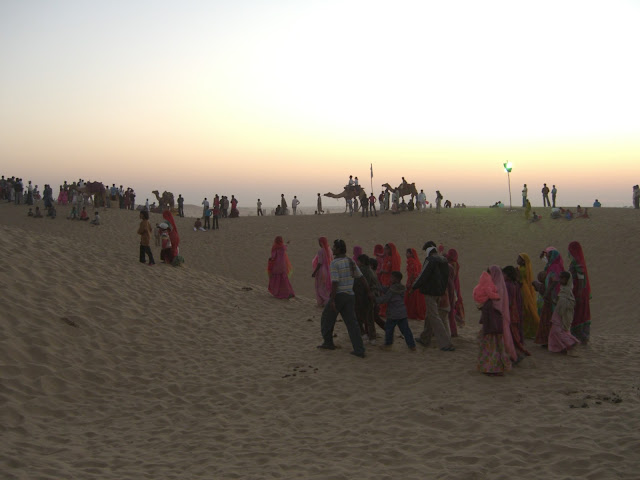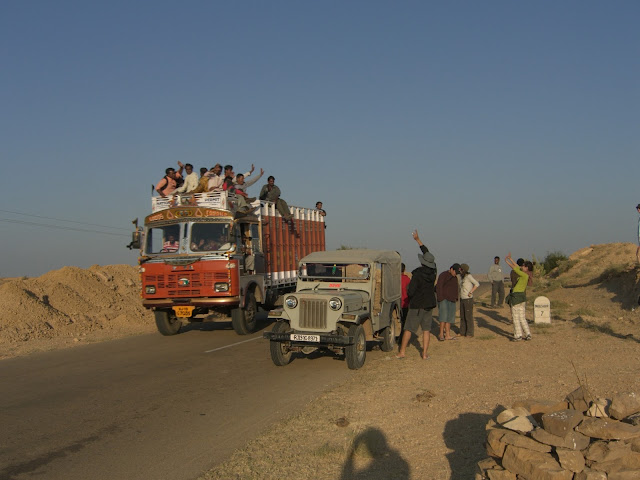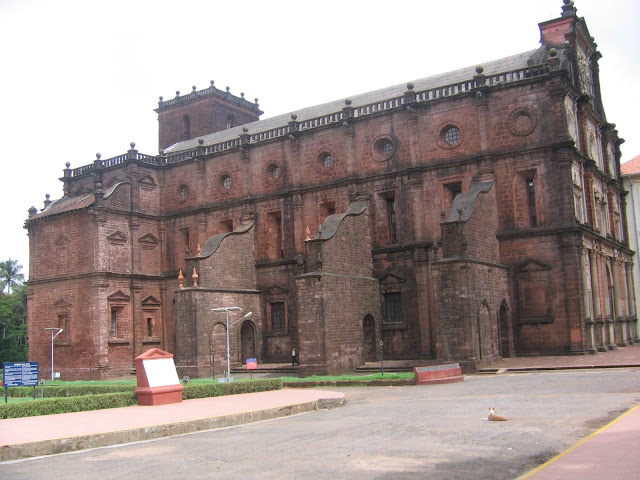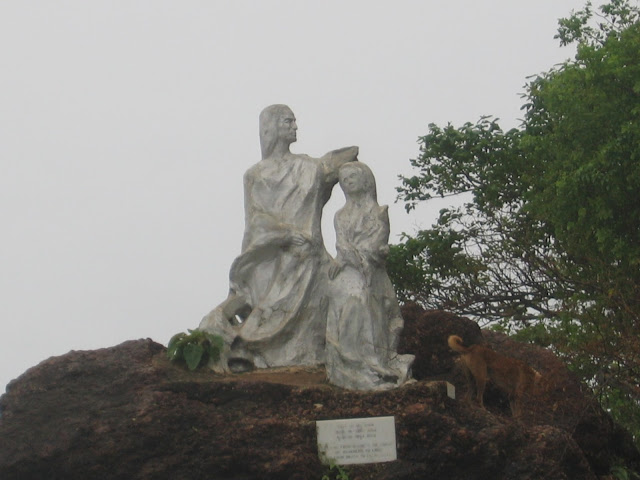We left Jaipur on a six
hour journey to Chatrasagar, a small town on the edge of the desert. None
of us knew what to expect, as we were going to be staying in tents – a sharp
contrast to the five-plus star palaces that we had so quickly become accustomed
to.
Our guide Raghu assures us that there is running water – whenever we need
water, he will run and get it! He tells us not to worry, that this place
is DAMN AMAZING.
Any anxieties about what
to expect were immediately forgotten the second that we hit the road, and
India high way driving Anxiety overshadowed all of our other anxieties (including
the snake phobias that some of the women had and the shopping phobias that the
men continue to suffer from – seriously, mention the word ‘shopping’ and, like
Pavlov’s dogs, the men reflexively lower their arms to the groin area and cover
their pockets).
I know that I have
already described the Indi(an) 500 experience, but the India highway driving on
the road to Jaipur experience kicked up the adrenaline a few thousand
cc’s. For much of the journey, we were on a highway that is very similar
to the road to Hana in Hawaii – only instead of ocean and lush greenery, we are
surrounded by clay shoulders still flanked by dilapidated corrugated tin-roofed
shops interspersed with people, cows, goats and sheep, donkeys, camels, and
motor vehicles. The main predator is the one lane road that is occasionally
challenged to accommodate all of the above, going both ways.
I vividly remember my
first experience on a windy one-lane road in Israel (with hairpin turns around
obstructed-view stretches). Of course, having only travelled on twentieth
century two-plus lane highways, we had no clue as to what would happen if two
cars racing in opposite directions met in Mexican standoff fashion. The
guide said that there was only one thing to do – pray. And that is what I
did throughout this journey.
I hadn’t realized that
the rest of our group were also religious – but every few minutes I heard
shrieks of ‘oh god’ (and maybe even a few hail Marys). All the while, our
hero driver Sanjay calmly continued on his drive, playing that loud Indian
highway music (different tones of horns beeping away). I later find out
that different tones and cadences indicate the different actions that are
required – like get out of my f*ing way, move over one inch so that we can
comfortably pass with a five centimetre perimeter between us, change the angle
of your vehicle so that its trajectory path is 45, not 90 degrees).
At first I would have
described the auditory experience as a cacophony of horns. But on these
trips, I would say that it is more like an opera – with the beeping of the
horns serving as the dialogue that is sung in operas.
Raghu tells us that the
highways we will travel are graded in different levels – I think it was 1 to 5
(small one lane-ers surrounded by mud and gravel graduating up to modern
divided concrete highways). One thing that stands out in memory is the
fact that no matter how modern or how divided the road is, and no matter how
developed or sparsely populated the area – there were no breaks in the chain of
people, animals, and vehicles on either side of the road. So far, I have
not seen one foot of completely open space in India.
At one point, a woman
with leathery brown skin and a dust-covered sari was sitting cross-legged in
the middle of a highway, cradling her infant/toddler son. At first, I thought
that this was Indian style hitch-hiking and that she was waiting for a
lift. But then she looked up with those gaunt brown eyes and that
desperate expression, and pointed to her son.
I wasn’t quite sure what she meant, but then she stood up near the window and
kept pointing to me and then to her son, indicating that her son is starving
and I could help feed him at least one meal.
I have a flashback of the scene at the airport upon our arrival - one child
approached me for money, and since I didn’t have any rupees, I pulled out my
pack of jolly ranchers and gave him one. Then…. out of nowhere, five
other kids swarm me, waving their hands to grab at a candy; having divvied up
all the candy, I pulled out the gum, and then ten more came to swarm me.
It was really an uncomfortable experience for me, because they kept on moving
with me as I made my way to the bus, many of them coming back for
seconds. In any case, I wondered whether my gut reaction to give the
mother some money would bring on a swarm. So I gave Ragu a few rupees to
give to her, and she summoned up the energy to thank me with a smile.
As we approached small towns along the way, the roads opened up and the normal
floods of people surrounded us. We noticed that there were many more cows
on the road than we had previously seen in the larger towns, and Raghu
explained to us that this was the rush hour for cows that were returning from a
hard day of roaming from house to house, where they were fed chapatis and
veggies. In fact, it is a daily ritual for Indian women to bake chapattis
– some for her family and some for the cows.
Seriously, even though the cows are owned by a family, they are fed by
villagers as they roam around, and chapatti is one of their staples. Ragu
reminds us that the expression HOLY COW! is not only the expression of
disbelief that most comes out of the mouths of most foreigners when they arrive
in Delhi. It is a reality – each and every bovine is a Holy Cow, and it
is a duty (and an honor) for Indian people to feed them. At the end of
the day, the cows return home to their rightful owners, creating a cow-jam on
the road. We speculate that this is the origin of the response that our
parents would give when we asked them how long we would have to wait before we
got some toy or whatever, and they replied – ‘you can wait ‘til the cows come
home’. The cow-jam is joined by a camel-jam (they, at least, travel in
single file, led by their owners) and a sheep jam being herded by a
red-turbaned shepherd who is slowly moving the flock of sheep along their path,
undisturbed by the loud honking of horns) and an occasional elephant-jam.
There is a unique riff with a special pitch of beeping for animals – it’s a
little less urgent and more respectful a sound than most other tunes.
We finally arrive at our destination – any reservations about sleeping in a
tent on the edge of a desert were quickly dispelled. Although we thought
that it was a mirage, it was a real oasis. Treed surroundings with a
small camp of ten or so large white tents (each with a wood floor and comfy bed
and a large bathroom) set atop a hill that overlooked a glassy CLEAN lake.
We arrived in time to
climb a hill to watch the sunset – mother nature in her splendour – calm and
serene – for me, it is some reassurance that what some of us refer to as god
(or Vishnu, or perfection of being, or mother nature) really does exist in
India.
For once, I felt like
this part of the journey was an Eat-Love-Pray experience (no shopping in site).
My suspicions were confirmed when we were greeted by Favio (he called himself
Raj, but he was as handsome as Julia Robert’s Favio – six and a half feet tall,
light brown skin accentuated by shoulder length black shiny hair and the most
beautiful eyes). Apparently, I wasn’t the only one whose heart was taken
– another of my new sisters had later commented on how beautiful Raj’s belt
was, and we all chimed in together that in order to have gathered that much
detail, she must have been staring at that region of his beautiful body for
some time.
We wash the grime of the
road off our bodies in our luxurious tents, and dine on the most delicious
dishes that are prepared with ingredients that are grown on the property.
The next morning we wake up to experience the beautiful sunrise on the lake,
and we head off in jeeps to visit the farm and crops that surround a small
village.
Although I have been
through several small villages in different countries, this is the most unique
one I have been fortunate enough to witness. First, we visited a very
small school of children, and were taken by how sweet they were, and the fact
that they were all attentive and respectful of the teacher (they sheepishly
turned to smile at us discretely so that the principal would not see). We
came just in time for morning exercise, and we noticed that there were about
fifteen uniformed children sitting outside the group on the ground.
Apparently, they were late for class, and were separated from the rest of the
class, as they were going to be punished after Morning Prayer.
We were all worried that
there might be some type of public caning ahead – we all sighed in relief as we
watched them pay penance – fifty jumping jacks! On one wall, there were
about ten names and numbers painted on the stone, and we asked Raghu to find
out what that was. He told us that that was the ‘donor wall’ and the
numbers were the donation amounts (no more than a few hundred dollars
each). We asked our guide if we could collectively contribute $1000.00 –
not just for a spot on the donor wall, but because we were all moved by the
sparseness of the learning environment (they had one computer for the school –
not for the children to use, but just as a demo to show them what a computer
looked like).
Raghu asked the
principal if they would accept our donation and he replied that they did not
accept donations (we didn't even ask for a tax
receipt - honest). So we asked if we could buy some books or
pencils, and were again told that they had everything they needed at the school
and that they really did not want to change a thing – because they were happy
with what they had.
As we walked through the
village, we saw that the villagers really were happy. There were smiles
on faces, and children that were being cared for by mothers, fathers, and
grandparents. The village was planned with civil-engineering foresight –
the shops that emitted smoke were situated far away from areas that were
populated by the people, etc.
We watched a demo of
pottery-making (a large stone wheel that was turned by hand – providing the
potter with both a workout and as effective an instrument as any modern wheel.
The artist who painted
the pots with a precision and uniformity of design used white Lyme that she
painted on with a donkey hair brush (yes, the Lyme hurts at first, but she
becomes immune after the first thousand pots). There was a pit in the
ground that served as a barbeque for the kiln. Apparently, the pots last
for six months – so everyone gets new pots for Diwali and for the holiday in
August, and they throw out the old ones in the pit – pretty efficient, if you
ask me. There were trades of all types in the village (the potter, the
baker, the shoemaker). The sight that was most hilarious (fortunately, we
were able to stifle our belly laughs until we got back to the bus), was the
ninety year old scrawnily bearded white haired barber who was sharpening his
razor and showing us his tools.
Okay, that might have
been not THAT atypical in India – but get this – the guy was blind!!!! And
every time he tried to put his tool away into the right hole in the box, he had
to try three different spots before he found the right spot. SERIOUSLY!
Raghu asked if anyone wanted to be a volunteer for the demo that would prove
that he still had his barber mojo – even though he had retired from formal
practice and was merely doing a few jobs here and there on the side.
We tried to convince
Alex to volunteer to take the shave….. but no go. We were actually happy
– we wouldn't want Alex to be in any harm’s way. He and Raghu have been
the heroes of the trip – both having planned each and every step of the way
with the company manager, making sure that every detail was attended to
so that we would have a 100% DAMN AMAZING experience.
We all thank Alex from
the bottom of our hearts, and Harriet – for being a tour operator widow these
past several months. We left with brimming hearts – reassured that there
are still communities of people that live happily in harmony, with minimal
needs that are cared for by wise planning, hard work, and the fruits of Mother
Nature. It was like a trip back through a time warp, visiting what might
have been the ancient beginnings of a kibbutz.
After our return to our oasis and a wonderful meal and good-byes to Favio, we
are sad to leave this peaceful haven. Raghu assures us that our next
accommodation will be even more amazing… and he is right. Hours later, we
have jetted through the time warp several hundred years, and we arrive at a
7-star estate – fifty acres of beautifully manicured grounds, marbled statues,
beautiful infinity pools – 87 rooms staffed by at least 870 people… I
can’t describe it, and I am actually embarrassed to admit that I have stayed in
this lap of luxury.
That was trumped by having fourteen people who started the journey as three
sets of two or three couple/friends and evolved into a large, close, happy and
loving family (only without the dysfunction!). THAT was trumped by being
blessed with a DAMN AMAZING head of the family – Raghu, who tirelessly found
the best deals at the most unique stores, gave us options for tour sites (he
didn’t even show an iota of disappointment when we were palaced out and asked
to skip the famous Crystal Palace), polled our every whims and wishes, leading
us through amazing experiences with the warmth and attentive caring of a
grandparents (only he’s only 30, really cute, has the best white-teethed brown
faced smile in the world, is extremely intelligent and knowledgeable, and one
of the warmest people ever). We all howl when he cracks up hysterically
every time he makes a joke – his laugh is very unique and it is TOTALLY
infectious.

All
of the above is hugely trumped by INDIA – an amazing country of at least ten
different countries within, with different dialects (several hundred of them),
vastly different foods, cultures, religions, standards of living…. mostly, a
throw-back to a century or so, with no real sense that it will ever modernize
to the point of having a Boston Pizza, phone wires don’t intertwine like
spaghetti strands sprawling from roof to roof, or roads that don’t carry
chaotic swarms of people cows, sheep, scooters, camels, elephants, cars,
tut-tuks, rickshaws, buses, trucks, and whatevers…
It is our last day of this journey. We spent yesterday in Udaipur – the
City of Love – a beautiful city of 700,00. It approximates what we
would think of as a ‘normal’ of city in a non-North American country. For
the first time in almost two weeks (with the exception of Chatasagar), there is
no pervasive smell of urine and cow dung… no fog or smog - only blue sky,
sunshine, and fresh air. We laugh at the stocks of Imodium, alka-seltzer,
diaper wipes, toilet paper, power bars, Astronaut Food (like the freeze dried
Beef Stew that Brian thought that he would eat after a few days of starvation
because he did not want to risk getting sick from Indian food – he gave it away
to one of the guides in the first week of the trip), etc. that is still in
their original packages. We wonder if Superstore will let us return them
when we get home on Friday night. We have all been deeply moved by this
wonderful country, and vote for a change in the acronym INDIA to Incredible,
Not for believing, Damn amazing, I want to come back, Awe inspiring INDIA.
Namaste
Cat





















.JPG)

